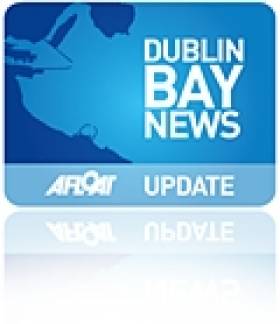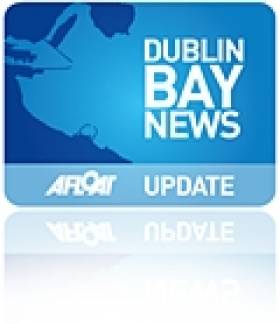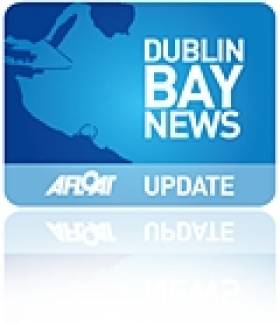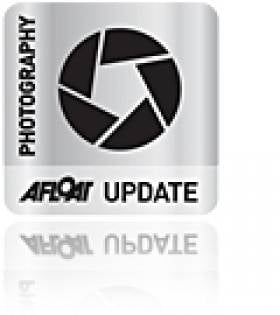Displaying items by tag: Dublin Bay
Sutton Dinghy Club to Stage Dublin Bay Sponsored Sail
Dublin bay's Sutton Dinghy Club is staging its first annual sponsored Sail between 3-6pm on 3rd July, a fundraising venture for a new rescue boat. The sail will follow a 10km route from the Dinghy Club down the creek to Dinghy Supplies on the Dublin Rd. More details on our forum here.
Keith Poole's 'The Gruffalo' made the most of the fact that several of the top Flying Fifteens were sailing the Northern Championships on the Ards Peninsula this weekend when he took a first and second in today's Dublin Bay Sailing Club races. Frank Burgess in Snow White Beat Grufalo in Race one but Poole struck bac k later in the afternoon to win from Tom Leonard's Mellifluence in the second race. Full results for June 12th Dublin Bay Sailing Club Results below:
DUBLIN PORT Dublin Bay Sailing Club Results for 12 JUNE 2010
BENETEAU 31.7 - ECHO 1. Legally Blonde (C.Drohan/P.Egan), 2. Thirty Something (Gerry Jones et al), 3. Flying Machine (Conor O'Gallagher)
BENETEAU 31.7 - 1. Legally Blonde (C.Drohan/P.Egan), 2. Thirty Something (Gerry Jones et al), 3. Flying Machine (Conor O'Gallagher)
CRUISERS 0 - ECHO 1. Lively Lady (Derek Martin), 2. Tsunami (Vincent Farrell), 3. WOW (George Sisk)
CRUISERS 0 - 1. Lively Lady (Derek Martin), 2. WOW (George Sisk), 3. Tsunami (Vincent Farrell)
CRUISERS 1 - 1. Jalapeno (Dermod Baker et al), 2. Powder Monkey (C.Moore/M.Byrne), 3. Xtravagance (Colin Byrne)
CRUISERS 1 - 1. Powder Monkey (C.Moore/M.Byrne), 2. Jetstream (Peter Redden), 3. Jalapeno (Dermod Baker et al)
CRUISERS 2 - 1. Jawesome 11 (V.Kennedy/M.Dyke), 2. Dick Dastardly (B.Cusack et al), 3. Red Rhum (J Nicholson)
CRUISERS 2 - ECHO 1. Kamikaze (P.Nash/B.McIntyre), 2. Red Rhum (J Nicholson), 3. Jawesome 11 (V.Kennedy/M.Dyke)
CRUISERS 3 - ECHO 1. Papytoo (M.Walsh/F.Guilfoyle), 2. Carrabeg (D.Martin/R.Deasy), 3. Pamafe (Michael Costello)
CRUISERS 3 - 1. Two Step (Ross Doyle), 2. Asterix (J.Counihan/F.Meredith), 3. Papytoo (M.Walsh/F.Guilfoyle)
CRUISERS 4 - 1. Rascal (K.Burke/S.Milner), 2. Ghrazel (Charles Pearson), 3. Maranda (Myles Kelly)
DRAGON - 1. Diva (R.Johnson/R.Goodbody), 2. Zinzan (Daniel O'Connor et al), 3. Zu (P.Dee et al)
DRAGON – Race 2 1. Zu (P.Dee et al), 2. Diva (R.Johnson/R.Goodbody), 3. Zinzan (Daniel O'Connor et al)
FIREBALL - 1. Goodness Gracious (Louise McKenna), 2. Incubus (S Oram)
FLYING FIFTEEN - 1. Snow White (Frank Burgess), 2. The Gruffalo (Keith Poole), 3. Gekko (S & P Nolan)
FLYING FIFTEEN - 1. The Gruffalo (Keith Poole), 2. Mellifluence (Tom Leonard), 3. Snow White (Frank Burgess)
GLEN - 1. Glendun (B.Denham et al), 2. Glenshesk (L.Faulkner et al), 3. Glenluce (D & R O'Connor)
IDRA 14 FOOT - 1. Dunmoanin (Frank Hamilton), 2. Sapphire (Lorcan O'Sullivan)
IDRA 14 FOOT - 1. Sapphire (Lorcan O'Sullivan), 2. Dunmoanin (Frank Hamilton)
MERMAID - 1. Lively Lady (G O'Neill & M Hanney), 2. Jill (P.Smith/P.Mangan)
MERMAID - 1. Lively Lady (G O'Neill & M Hanney), 2. Jill (P.Smith/P.Mangan), 3. Tijuana (David Creedon)
SHIPMAN - 1. Kelema (N.Blake/Z.Grace), 2. Euphanzel lll (Louis McSherry et al), 3. Ruadh (J.O'Connor/J.O'Callaghan)
SQUIB - 1. Buzz Lite (G.O'Connor/B.Foster), 2. Lola (Frank Whelan), 3. Anemos (Pete & Ann Evans)
SQUIB - 1. Lola (Frank Whelan), 2. Ladybird (M.Muldoon/B.Stevens), 3. Anemos (Pete & Ann Evans)
WHITE SAIL CRUISERS - ECHO 1. Finnegans Wake (T.Rowlands et al), 2. Afternoon Delight (Michael Bennett et al), 3. The Great Escape (P & D Rigney)
WHITE SAIL CRUISERS - 1. Windshift (R O'Flynn et al), 2. Act Two (Michael O'Leary et al), 3. The Great Escape (P & D Rigney)
Gringo Wins Dun Laoghaire Motor Yacht Club Regatta
The Dublin Bay Sailing Club Commodore's yacht Gringo was the Class one winner of Saturday's Dun Laoghaire Motor Yacht Club Regatta.Tony Fox beat John Hall's Something Else for the top result on IRC handicap.No results are available for Class Zero yet according to the DMYC website. The regatta was sailed in 8-10 knot southerly winds and the event replaced the normal Dublin Bay Sailing Club (DBSC) Saturday race. Other class results from the event are published here.
Six Star Cruise Liner Arrives in Dublin Bay
A 670-foot cruise liner, one of the most luxurious in the world, arrived in Dublin Port this morning. The six star Seven Seas Voyager is the world's second all-suite, all-balcony ship and the second to feature a restaurant operated by Le Cordon Bleu of Paris, following sister ship Seven Seas Mariner. There are four main dining venues, surprising for a ship her size. The ship sailed from Belfast overnight. More details here.
Ew, what's that smell?
Cruiser Racer visitors to Dublin for this weekend's Cruiser Nationals aren't the only ones to be put off by Dublin's Bay foul smells it appears. Residents in Dublin have in recent days reported sewage like odours in the north and south of the bay. The smell is reported as far inland as Stillorgan. Diggers have been seen removing brown slude from city beaches but a City council spokesman says it is a naturally occurring algae. More on the matter in this morning's Irish Times here.
Cruise Liner with Giant Lips Visits Dublin
A Cruise liner berthed on the river Liffey this morning will draw a smile from Dubliners because of the giant red lips and eyes painted on the ship. The Aida Aura is a 203m long vessel carries 1400 passengers and is operated by the German unit of P&O Cruises.
This morning's opening race of the Liebherr 2010 ICRA National Sailing Championships has kicked off in style on Dublin Bay and although the 120 boat fleet (drawn from 20 clubs) was shrouded in a sea mist for a time race course reports indicate tight racing in southerly breezes of over 10 knots.
Jump Juice in Division Zero damaged her pulpit and at one stage was dealing with a man over board. They have reired from today's racing. A lady crew member from another boat has been brought ashore with two borken teeth.. More updates as we have them. Photos from the race course are on our gallery now.
All classes are underway. Divisions Zero and One have two round the can races, and Divisions two and and three have three windrward leeward races today. the white sail fleets have two round the can races. The fleet is expected back ashore around 4pm.
Photos from this mornings racing by Bob Bateman are already on the Afloat gallery here.
Royal St George Pontoon Arrives in Dun Laoghaire
Preparations continue apace in Dun Laoghaire for this weekend's ICRA Championships at the Royal St. George YC. The 'club of the year' is installing new pontoons in front of its club house in time for the Cruiser event and in anticipation of plenty more regattas this summer. Our exclusive photo by Gareth Craig shows one of four of the 80 metre long pontoons being towed in to position at the harbour this afternoon. The 250 tonne pontoons from SF Marina ssystems in Kilkenny were towed across Dublin Bay from Dublin Port in particularly calm weather after the weekend's nortwesterly winds.
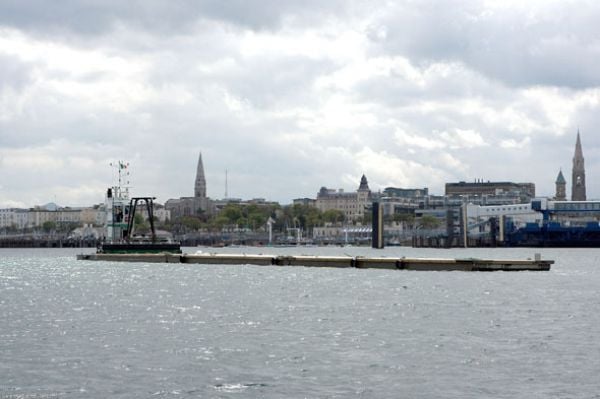
Royal St George Win Cumberland Cup
With a close to perfect score, Andrew Fowler's team of Sam Hurst, Brendan Fafliani, John Sheehy, Nick Smyth, Guy O'Leary, Peter Bailey and Phil Lawton from Royal St George YC in Dublin, won the 2010 Royal Thames Cumberland Cup from Ian Ilsley's team from Yacht Club de Monaco writes Malcolm McKeag. Firm friend and arch-rival of the home side the Southern Yacht Club of New Orleans was third, claiming by dint of that result the Bourgne Cup, contested on each and every occasion the clubs meet, in whatever larger competition..
Over three days at Queen Mary Water hard by Heathrow airport the seven teams sailed a total of 54 races in the international yacht club contest, ferried to and fro from the RTYC's Knightsbridge clubhouse in that iconic symbol of London, a bright scarlet Routemaster double-decker omnibus.
Sailing in a fleet of eight carefully-matched modified J80s the competition began with a two-day double round-robin in which each team raced each other team twice. St George topped the league, winning 11 out of their 12 matches and losing only to the hosts and current holders, Royal Thames, and thus apparently setting the scene for the finals. It was a scene dramatically re-shaped by the winner-take-all nature of the Cumberland Cup's competition structure.
With teams travelling from across the globe to compete in this regatta, the organisers deliberately eschew a competition format that eliminates teams early from the competition, espousing instead a format that keeps every team sailing into the final round. The result is The Ladder, which as some teams including the hosts found to their cost might be better termed The Greasy Pole. On The Ladder, a win carries the double bonus of promotion to the next rung – but every loss earns the double-penalty of relegation. On The Ladder, it is just possible by dint of really good sailing to redeem a disappointing result in the round-robin and climb all the way to the top – as did the Monegasques – while the series leaders – in this case the Irish – must not put a foot wrong if they are to retain their fingertip grip on the crown.
Thus on Sunday The Ladder's first and lowest rung saw the Germans face-off against the Kiwis for a chance for stardom, while Royal St George had to wait patiently to see which of the Yanks (and it's not often the team from New Orleans are called Yankees!) and the Brits would be first to step up to try and knock them off their perch. As matters transpired, it was Royal Thames who beat the Southerners to race against the champs: to no avail. Royal St George won.
After Round One, the Brits began what turned out to be their slide down The Ladder, while the visitors from the Mediterranean climbed ever higher. The Southern, meanwhile, had to dispose of Royal Port Nicholson if they were to have a chance, in Round Three and the final round of The Ladder, of another crack at the leaders.
With Port Nich out of the way, the crunch race in Round Three was that between the Southern – highly vocal as always – and Monaco, who had quietly beaten Royal Thames when Ben Clothier of the host club earned a penalty for inadvertently but illegally 'sculling' the boat with the rudder while trying to slow down to block his rival. Given that in the round-robin YCdeM had lost almost as many races as they had won (and then been penalised a further point for a violent T-bone collision in their early race against St George) it is not unkind to suggest that their presence, by Round Three, on the top rung of The Ladder had been predicted by few. But Ian Ilsley, their team captain who by his own admission 'hadn't team raced for years' had by now earned both the respect of his rivals and the nickname 'the Old Fox'.
Southern, in blue jackets, began by blowing the yellows away at the start to be a comfortable and apparently safe 1-2 at the windward end of the course – but somehow one of the YCM team managed to get close enough on the long run to engage a blue boat and suddenly it was Game On again. On the final beat all four boats were mixed together and the denouement came – as so often in this two-boat team racing where the crucial factor is that the team with the boat in last place loses the match – at, beyond, above and back round again to the finishing line, with a Southern boat blocking out one Monaco boat only to find his own way back blocked by the other Monaco boat. And vice versa. Finally a Southern boat crossed the finish line – only to cop a penalty by blocking the path of the last returning Monaco boat under the rule that says a boat no longer racing must not interfere with one that is still racing.
And so it was a Monaco-Ireland final. If anyone thought this would be a walk-over for the Irish, they were wrong. Monaco had their tails up and no mistake. Once again it was their down-wind sailing that kept them engaged and it was not until the final mark, when the Monaco boat in second earned a penalty, that it really was Game Over.
Monaco were justly pleased with their Ladder climb from 4th place after the Round Robin – but none could nay-say the Irish for their win. 15 matches sailed and only one of them lost.
Photos below and on our gallery by Ingrid Abery





More photos here on our gallery.






























